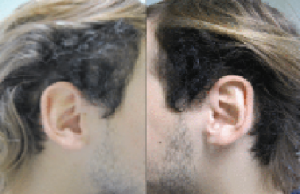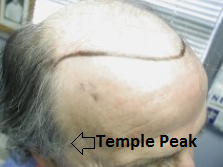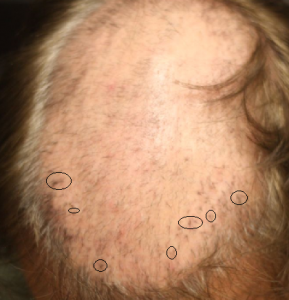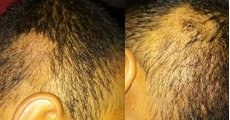50 percent of women over 50 have thinning hair. So they are not immune. Their estrogens support their hair and when the estrogen levels drop with menopause, the androgens take over and the genetic that impact men start showing;,however, most women do not develop pattern balding just generalized thinning. Many women in their 20s and 30s also have a special type of female balding that is different than men.
Yes, you can transplant hair from any part of the body to any other part of the body. The problem with body hair is the length of the growth and sleep cycle. Scalp hair grows, on average, three years and each hair sleeps for five to six months. Body hair grows for about six months and sleeps six months. This means that you only get six months of growth from these body hairs and then they fall out and go to sleep. Only 50 percent of body hair grows at any one time. That is why we prefer either scalp hair (primary) of beard hair (secondary) because these hairs grow long. I have seen pubic hair transplanted to the head and it looks like pubic hair, not aesthetically pleasing.
There is a condition called ‘post finasteride syndrome’ (PFS) which reflect on people who keep their sexual side effects after stopping finasteride. Depending upon your age, ED is present normally in 20% of men in their 20s and 30% of me ,in their 30s, so it is often difficult to tell what is PFS or normal ED with age.
Have you tried Cialis or Viagra? These drugs are commonly used to solve the ED problems seen in men of all ages
Both Finasteride and Dutasteride are metabolized in the liver. The article here suggests that Dutasteride can impact fat metabolism in the liver which tells me that people who have known lover disease might stay away from Dustasteride. https://www.ncbi.nlm.nih.gov/pmc/articles/PMC4701851/#!po=40.9091
I have been seeing my hair go back every year since I was 17. I am scared that I will lose all of my hair. What can I do?
I would go on the drug Finasteride for a year and see if you can stop or reverse the loss. You have lost the frontal corner hairline as it is going up and the temple peaks are also gone. If this does not work, then a hair transplant would solve the problem very nicely.
I might have even been younger than that I just remember 7th grade biology we were learning about genetic traits such as widows peaks and when I pulled my hair back the whole class noticed my pronounced peak. This was hidden until college as I always had long hair until it started to get real bad. Now that I think about it middle school or possibly earlier seems very rare for balding especially with no family history. Should I get checked out?
The Widows peak is a remnant of the juvenile hairline. Imagine the tip of the widows peak as the point at which the juvenile hairline was. As it recedes, it leaves the widows peak behind. You never see a widows peak in a 5 year-old, yet as children age (I studied over 1000 children from 5-18 years old) these widows peaks appear. In women, more than half of them have a widows peak which says that their hairlines moved up by a amount equal to the length of the widows peak. See my article below which has good illustrations in it.
https://newhair.com//pdf/2015/phenotype-article-published.pdf
The temple peaks can be lost independently from the balding process. I noticed that Ronald Reagan lost his peaks well before he became an old man but he kept a full head of hair. I also transplanted many full Class 7 balding pattern patients who kept their peaks despite losing their entire head of hair.
The photos below are of two different men. One man is losing his peak on the left side and already lost it on the right side. The second man is a full Class 7 patient who never lost his temple peaks despite losing all of his hair. I transplanted his balding head with 10,000 grafts but never needed to address his temple peaks. The two pictures below is before and after hair transplants.
This patient had hair plugs over 25 years ago. We fixed his frontal hairline in 2003 but he still noticed the plugs so he switched to a hair system. Now he wants to get rid of it and I gave him a plan that would do just that. The photo below shows (inside the circles) some of the many plugs on his scalp that should be removed with FUE. With better instruments than we had in 2003, we have become very good at FUE.
When I pulled back his hair and revealed his hairline, his hair looked almost perfect but he was conscious of the plugs that can clearly be seen with his scalp shaved for his hair piece.
The Solution:
(1) remove the plugs using FUE;
(2) put enough hair around the frontal area to give him volume; and
(3) follow-up with Scalp MicroPigmentation to fill in everything once the next to last hair transplant is done.
This patient had so many plug surgeries 25 years ago, he is almost out of donor hair, a real challenge for us.
You had 5500 FUE grafts which is almost certainly too many grafts for your donor supply. You now have donor area depletion which is essentially balding of the donor area because too many grafts were removed from the donor area. This area will not recover. The only treatment for this that could help you hide the balding in these areas is scalp micropigmentation which, although is not hair, will hide the balding if you keep your donor hair very short. I believe that too many doctors are being pushed by many patients to perform more and more FUE transplants to fill in the balding area. This is the result if pushing the technology. Doctors should assess the donor density and know just how many grafts the donor area will support before doing the surgery.
I am away in Ireland this week and saw the rain come down hard for a short while. One person at the hotel commented that it ‘was raining cats and dogs’ out there. At it turns out, this phrase reflects a unique situation in Ireland in the days when everyone had a thatch roof (made of straw packed tightly together to keep the rain out, the picture below shows a thatched roof made of straw).
The history of this phrase goes back to the days when most people had thatched roofs and in the winter, when the houses got cold, the dogs and cats would find their way into the thatched roof, digging themselves a hole to keep warm. As the roofs got older and started to leak because of heavy rains, the dogs and cats still crawled into their holes, and the roofs eventually gave way. The dogs and cats fell from their holes in the thatched roofs, falling into the house…. hence the term ‘it’s raining cats and dogs’.
In the 1400-1600s, the poor people of Ireland would sell their urine by peeing in a pot and bringing the pot of urine to the local tannery where they would get a few pennies for it. These people were know to be ‘piss poor‘. Urine was used to prepare the hides of cattle to make leather. Some people were so poor, they ‘did not have a pot to piss in‘ hence the phrase reflected the poorest of the poor. We have adopted the same phrase today to reflect a sense of poverty.
The third phrase we learned from the Irish ‘By Hook or By Crook‘, really reflects two towns between Waterford and Wexford (actual names of towns). A particular road forked and one way took you to the town of Hook and the other road took you to the town of Crook. If you were a determined traveler (or in the case of the English General Oliver Cromwell whose mission was to concur the Irish with an army of 3000 troops in 1649) you could get to whichever town you wanted and he was determined to concur these towns by whatever road it took to do it. The phrase has come to mean that people who are determined to achieve their goals, will do it ‘By Hook or By Crook’
Isn’t language wonderful. I am writing this in Ireland. Have a wonderful 4th of July.







